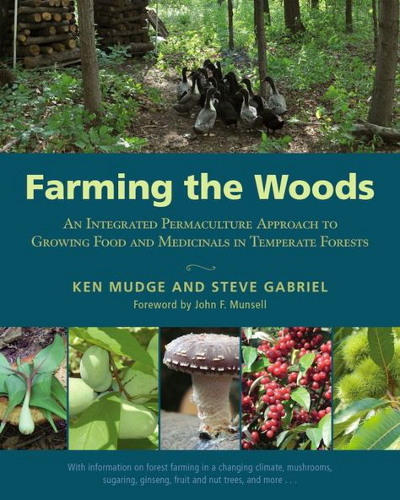
Farming the Woods
 I
have a love-hate relationship with books from Chelsea Green. Their
titles are so enticing...but the price tags are daunting and about half
of the books ultimately disappoint once I crack them open. Farming the Woods
by Ken Mudge and Steve Gabriel was partially inspiring and partially
disappointing, with a dry and academic tone and far too much basic
information, but with beautiful pictures and hands-on information that
made reading worthwhile.
I
have a love-hate relationship with books from Chelsea Green. Their
titles are so enticing...but the price tags are daunting and about half
of the books ultimately disappoint once I crack them open. Farming the Woods
by Ken Mudge and Steve Gabriel was partially inspiring and partially
disappointing, with a dry and academic tone and far too much basic
information, but with beautiful pictures and hands-on information that
made reading worthwhile.
The most helpful part of the book was the authors' realistic notations on which plants will really
produce in the shade. Despite forest-gardening literature to the
contrary, Mudge and Gabriel report that in a woodland setting with more
than 40% canopy cover, the only species that reliably bear fruit are
pawpaws, elderberries, ramps, and mushrooms. At 25 to 40% shade,
shisandra, hawthorn, currant, gooseberry, honeyberry, hazelnut,
juneberry, and groundnut join the mix, although productivity is likely
to be significantly lower than yields in full-sun environments. For
example, hazelnuts produce about 70% of their optimal yield in 30% shade
and 30% of their optimal yield in 90% shade, so you have to decide at
which point the juice is no longer worth the squeeze.
Another useful facet of Farming the Woods
was the authors' analysis of which non-timber forest products make
economic sense. After all, for forest farming to be more than a hobby,
landowners need to be given an incentive to keep those trees standing
rather than selling them to the local sawmill. Although many non-timber
options were presented, the authors felt that the most economically
feasible include tapping sugar maples (and possibly birch) for syrup,
growing ginseng for roots, and raising shiitakes on logs. In addition,
chestnuts and hazelnuts can provide relatively lucrative nut crops, and
turning the forest into a nursery for shade-loving ornamentals can also
help pay the bills.
In the end, Farming the Woods
isn't the must-read permaculture book of the year that I thought it
would be, but it's definitely worth at least checking out of your local
library. Or maybe you'd like to be the lucky recipient of my lightly
read copy? Enter the giveaway below and you may get a copy of your very
own for free!
Want more in-depth information? Browse through our books.
Or explore more posts by date or by subject.
About us: Anna Hess and Mark Hamilton spent over a decade living self-sufficiently in the mountains of Virginia before moving north to start over from scratch in the foothills of Ohio. They've experimented with permaculture, no-till gardening, trailersteading, home-based microbusinesses and much more, writing about their adventures in both blogs and books.
Want to be notified when new comments are posted on this page? Click on the RSS button after you add a comment to subscribe to the comment feed, or simply check the box beside "email replies to me" while writing your comment.
- Remove comment
- Remove comment
- Remove comment
- Remove comment
